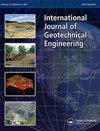不同采样算法下三不变塑性模型的灵敏度分析
IF 1.3
Q2 ENGINEERING, GEOLOGICAL
International Journal of Geotechnical Engineering
Pub Date : 2023-03-16
DOI:10.1080/19386362.2023.2208921
引用次数: 0
摘要
摘要采用Sobol灵敏度分析来识别用于有限元模拟的三不变土壤模型(GeoModel)中参数的重要性。研究了三种常用的采样技术,即伪随机、准随机(QR)和拉丁超立方体采样(LHS),以确定每种采样技术的灵敏度分析效率,并确定土壤模型的关键参数。在采样方法中,LHS表现出最好的采样均匀性,并且比其他方法提供更稳定的结果和更快的收敛性。分析结果还表明,杨氏模量和剪切屈服面的初始值是设计输出的最关键参数,可以定量测量最大总变形(MD)、塑性变形(PV)和塑性区尺寸(VY)。本研究中提出的灵敏度分析框架可应用于类似工程和科学问题的有限元模拟,以评估模型参数的影响。本文章由计算机程序翻译,如有差异,请以英文原文为准。
Sensitivity analysis of a three-invariant plasticity model with different sampling algorithms
ABSTRACT A Sobol sensitivity analysis is employed to identify the importance of parameters in the three-invariant soil model (GeoModel) for finite element simulation. Three commonly used sampling techniques, namely, pseudo-random, quasi-random (QR), and Latin-hypercube sampling (LHS), are investigated to determine the efficiency of each sampling technique for sensitivity analysis and identify the critical parameters for the soil model. Among the sampling methods, LHS shows the best sampling uniformity and offers more stable results and faster convergence than other methods. The analysis results also show that Young’s modulus and the initial value for the shear-yield surface are the most critical parameters for the designed outputs, which quantitatively measure the maximum total deformation (MD), plastic deformation (PV), and plastic zone size (VY). The proposed sensitivity analysis framework in this study can be applied to finite element simulations of similar engineering and scientific problems for assessing model parameters’ influence.
求助全文
通过发布文献求助,成功后即可免费获取论文全文。
去求助
来源期刊

International Journal of Geotechnical Engineering
ENGINEERING, GEOLOGICAL-
CiteScore
5.30
自引率
5.30%
发文量
32
 求助内容:
求助内容: 应助结果提醒方式:
应助结果提醒方式:


